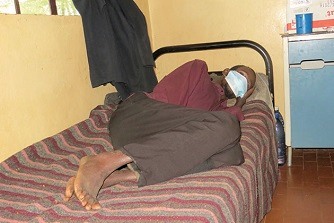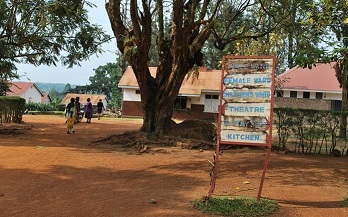TB drugs: poor countries hanging by the thread
Racheal Ninsiima
On November 28, 2013, Julius Kiiza, 26, a father of four, was diagnosed with MDR-TB – a multi-drug resistant Tuberculosis (TB).
Julius Kiiza was like many youths his age a few years back. He loved to hang out and live a good life. Never in his wildest dreams did he think he was developing a virulent form of TB.
Prior to this, Julius was already grappling with HIV which was diagnosed in 2011. Later he was to develop a wracking cough, characterized with chest pain.
“I would lose breath especially at night because of chest congestion,” he said.
Julius was diagnosed with TB and was started on the regular eight-month drug regimen. Five months down the road, Kiiza was found to have MDR-TB. MDR-TB occurs when bacteria do not respond to Isoniazid and Rifampicin, the two most powerful, first-line anti-TB drugs.
Because of Julius Kiiza’s co-infection (HIV and TB), he now takes at least 20 pills a day and he will be receiving an anti-TB injection daily for six months. I met him at Hoima regional referral hospital TB ward. As he motioned towards me, it was as if his legs would snap under the weight of his body.
New research eludes LDCs
While identifying those with the active disease will provide a long-term public health benefit, Moses Mulumba, a patent lawyer, says that without new, simple and affordable treatments for MDR-TB, this is impossible.
“If pharmaceuticals developed one tablet a day for TB, this would mean reduced pill burden and greater adherence. However, such developments for the developing world are deficient due to the lack of return on investment opportunities for pharmaceutical companies,” says Mulumba, the executive director of Centre for Health, Human Rights and Development (CEHURD).
Most recently, Britain/Sweden pharmaceutical, AstraZeneca announced it was pulling out of all early stages of research and development for malaria, TB and neglected tropical diseases to instead focus on cancer, diabetes and hypertension. Welcome to the world of intellectual property (IP), where giant pharmaceuticals determine drug availability and pricing.
Prices of drugs vary depending on whether the drug is under patent – 20-year protection by the manufacturer – or generic, where the patent has expired. In the private sector market, the brand/patented version of Linezolid, an MDR-TB treatment drug, costs $65 (approximately Shs 166,400) for a daily pill.
For a patient taking a pill a day for two years, this amounts to over $49,000 (over 125m). It is produced by Pfizer, an American pharmaceutical corporation. Generic versions of the drug, produced by Hetero, an Indian pharmaceutical company, cost of $8 (Shs 20,000) per pill.
When asked whether he would have afforded Linezolid had it not been provided freely, Kiiza laughed sarcastically: “I think I would have died a long time ago because I don’t have a cent!”
Because majority of Ugandans still survive on less than $1 (Shs 2,560) a day, Uganda receives TB drugs through aid. The case of ARVs provides a dramatic illustration of the global impact of Indian drug firms.
In 2001, Indian drug company Cipla, introduced first line treatment for HIV at $350 (Shs 896,000) per person per year, a stunning offer at the time. Other Indian firms followed Cipla’s model and today, 80 per cent of people living with HIV who are on treatment in developing countries rely on Indian generic drugs.
Trading away lives
Uganda being a member of the World Trade Organization (WTO) is under obligation to develop rules that comply with WTO guidelines. Among these is the Trade-Related Aspects of Intellectual Property Rights (TRIPS) agreement requiring all members to standardize minimum standards of IP, including patents for pharmaceuticals.
IP rights give the creator an exclusive right over the use of his or her creations for a certain period of time, such as 20 years, for a scientific innovation like medicine. The pharmaceutical industry in developed countries strongly depends on the patent system in order to recoup research and development costs.
“TRIPS sustain a regime of private monopoly rights which impedes access to essential medicines because of prohibitive prices. It also delays production and market entry of generics because producers will have to wait 20 years for a patent to expire,” Mulumba explains.
Moreover, countries such as India and Brazil where generics are produced, now grant medicines patents in order to comply with their obligations as WTO members. New drugs are already patented in these countries, meaning that production of affordable generics is now restricted.
Such a restriction led Cipla to establish Quality Chemicals Limited in Uganda because that law does not hold for LDCs. Under TRIPS, LDCs are supposed to enforce patents on all medicines by 2021. Tentatively, this means the end of all generic drugs.
In response to the TRIPS agreement, WTO delegates issued the Doha declaration on November 14, 2001 which exempts LDCs from implementing patent law for pharmaceuticals until January 1, 2016. This was extended to 2021 last year.
Enforcing patents in Uganda
To guarantee intellectual property rights to innovators, parliament this year passed the Industrial Properties Act. It spells out protection for products and processes in all fields of technology, including medicine.
Mulumba forecasts that the law will only work if there is government commitment to invest in research and development, develop human capacity and offer attractive incentives such as tax holidays to innovators.
“The law integrates flexibilities such as the bolar provision which enables researchers to’ reverse-engineer drugs even when the patent on it has not yet expired. But all the seven plants we have are not doing research because of high production costs,” he says.
Another policy is the Anti-Counterfeit Goods law which prohibits the manufacture, trade and release of fake goods on to the market. Contentious, however, is the fact that it regards generics as counterfeits.
“This is part of a global agenda to keep developing countries from importing from third parties like India and Brazil where the cost of production is much cheaper. All these things are happening because we are a disorganized lot. We Africans are doomed unless we wake up!” says Edgar Tabaro, a patent lawyer with Karuhanga, Tabaro and Associates.
Solutions to a global crisis
In 2000, the UN Security Council declared HIV a global security issue and resolved to establish a Global Fund (GF). GF is the biggest financer for HIV and TB programmes in Uganda, having channelled at least $200m over the years.
“In October, Uganda is sending the GF another proposal for HIV/TB funding to enable us scale up prevention and treatment efforts,” Prof Vinand Nantulya, chairman Uganda Aids Commission, said.
Uganda is also a member of WHO’s Global Drug Facility (GDF), the largest supplier of quality TB treatments. Nantulya says it is through this that the country procures TB medicines and innovative tools such as the GeneXpert at reduced prices.
“Uganda needs to develop collaborative research so that our scientists can catch up with others in the developed world and partnerships such as the Global Alliance for TB drug development should be more actively supported to allow for the development of drugs that are free of patent restriction,” Tabaro urges.
Currently, 11 TB vaccines are in clinical trials worldwide. WHO estimates that the earliest a vaccine could be licensed is 2020. BCG (Bacille Calmette Guerin) vaccine remains the only vaccine against TB in general use.
This story was supported by the African Centre for Media Excellence. The author can be contacted here: ninsiima@observer.ug.
_________________________________________________________________________________________
Source: The Observer (Kampala, Uganda). Photo 1: © N/A. Photo 2: Help Hoima
URL: http://www.a-w-i-p.com/index.php/2014/09/05/tb-drugs-poor-countries-hanging


























